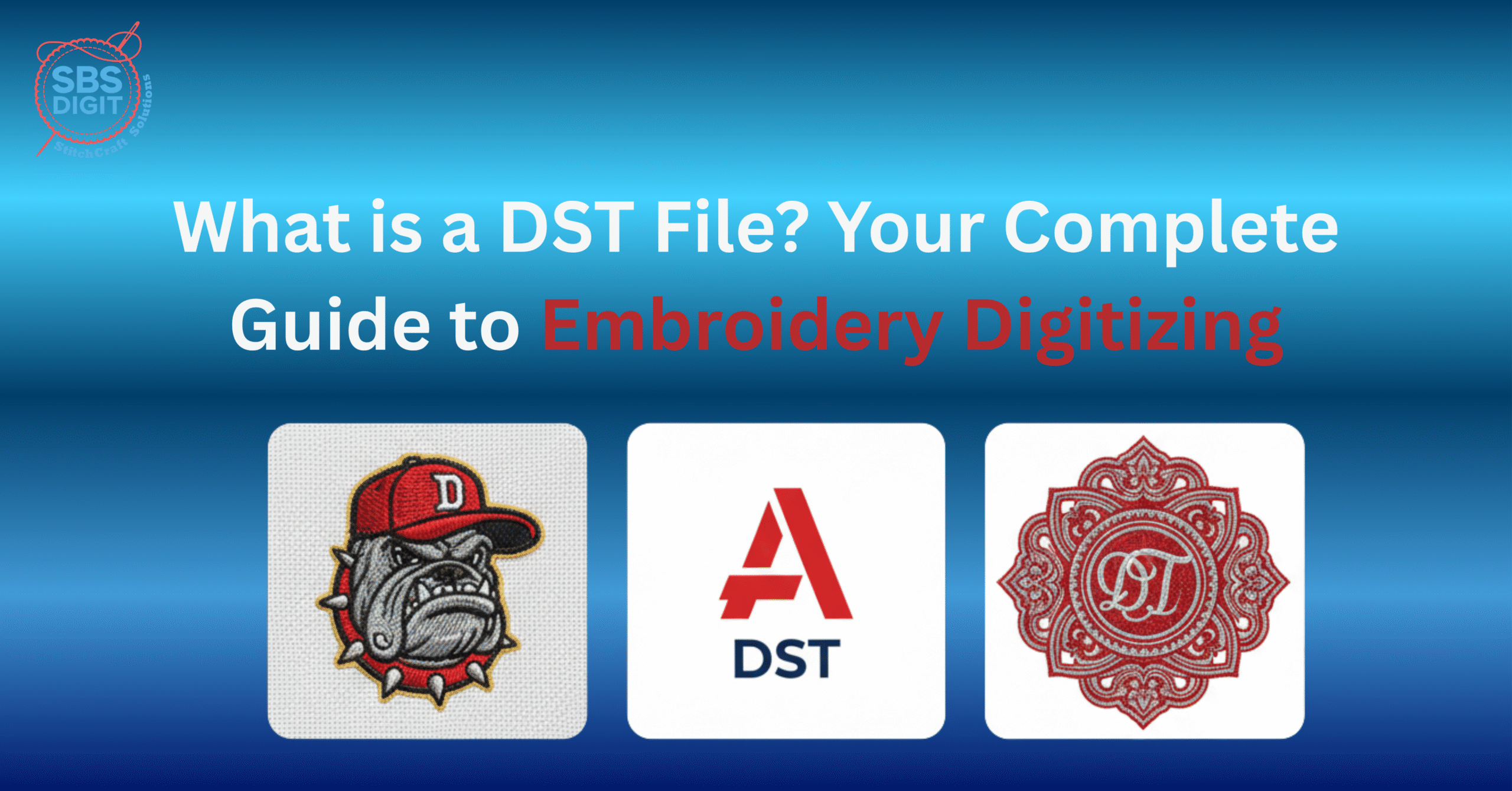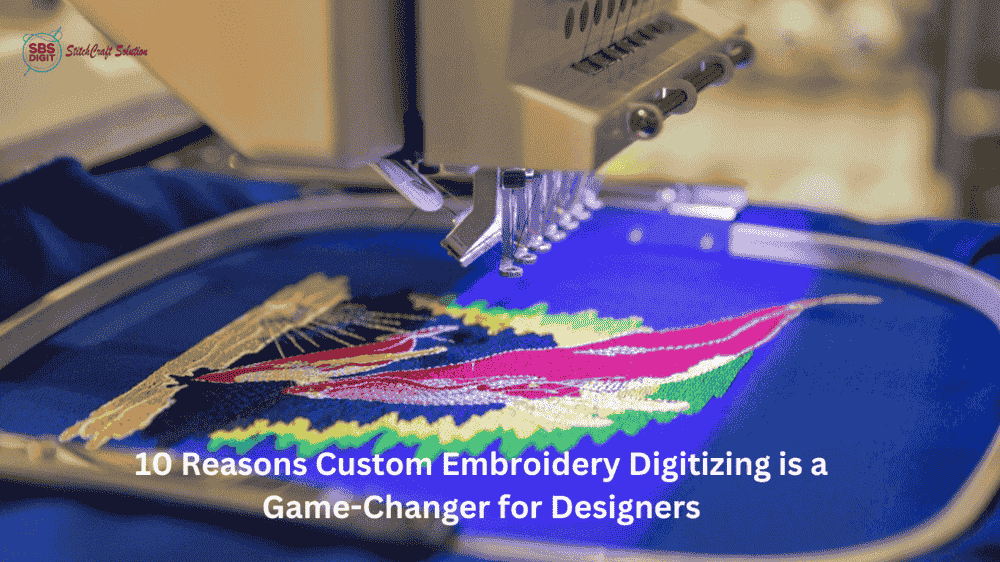If you’re looking into the machine embroidery industry it is likely that you’ve come across those mysterious letters, DST. For novices the format may be confusing, but knowing the DST file format is vital to creating your own designs. We at SBS Digit We are experts in professional digitizing and we are helping to simplify this crucial embroidery file type.
This complete guide will outline what’s the DST file that’s why it’s popular and how you can effectively create DST files to get the best result from machine embroidery.
1. What is a DST File? The Technical Core
What exactly is a DST file? what exactly is an DST file? The word .dst file refers to a unique embroidery machine file format created by the Japanese company Tajima which is one of the most renowned makers of commercial embroidery equipment.
Contrary to images files (like JPG or PNG) however, unlike image files (like PNG or JPG), a. dst document does not contain any visual information or color-related details. Instead, it’s a stitches file meaning it has a certain set of instructions that instructs the embroidery machine precisely what to do:
- Coordinates What is the location to place your needle in the next (X as well as Coordinates Y).
- Stitch types: Whether to use an edging stitch, a running stitch or a satin.
- Trims What is the best place to trim your thread.
- stops: What is the best place to hold to change the color manually.
Since it is a simple format with only basic instructions that are not very detailed, it is a basic format. DST style is referred to as a “read-only” (also known as a universal commercial format). This makes it extremely flexible since nearly all home and industrial embroidery machines can be read and executed the instructions within DST. DST embroidery files.
2. Why the DST Format Dominates Commercial Embroidery
The reason that the dst format used for embroidery is so widely used is a matter of it is compatible and efficient.
Universal Acceptance
The DST logo (the icon of the file) is used by nearly every commercial embroidery machine around the globe regardless of the brand (e.g., Barudan, Brother, Melco, etc.). If a professional digitizer is requested to format DST files, they typically choose this format since they are sure it works everywhere. This wide acceptance establishes that. dst document as the standard for industry.
Compact Size
Because the DST files contain only stitch coordinates, and not more complex object or color data The size of the file is extremely small. This makes them easy to load, simple to store, and quick transfer, which is a major benefit for commercial production in high-volume environments.
3. Understanding the Limitations of the DST File Type
While it is universally compatible DST type of file is not without its limitations, and users should know about:
| Limitation | Detail | Why it Matters |
| No Color Information | The DST format doesn’t save the specific thread colors that are used for the layout. | It will stop every specified color change point and the operator will have to choose the thread color manually. |
| No Object/Vector Data | It’s not an editable design file. It’s a compiled set of commands. | It is not possible to alter or modify the DST stitch files without risking the creation of distorted stitches or loosing quality. |
| No Machine Type Data | They are general and don’t contain specific instructions to be used on a specific device. | The operator is required to set manually tension or density as well as hoop limitations based on the size of the design. |
4. How to Make a DST File: The Digitizing Process
It is not possible to simply change the extension of an image (like JPG) to a .dst file. The process of changing artwork into an operational embroidery DST format is known as digitizing and requires the use of specialized software and knowledge.
The Role of the Digitizer
To create DST files DST document, an expert digitizer like SBS Digit is required to follow these essential steps:
- Review the artwork: The digitizer determines the most efficient direction of stitch, density and underlay depending on the fabric as well as the size you want.
- Manual conversion: The software used to plot each stitch, determining the exact the type of stitch (e.g. running stitch for outline and the satin stitch to create columns) and the density to achieve the best outcomes.
- Optimized for Machine: They add instructions for trimming threads as well as jump stitches and color stops. This critical step converts designs into machine-friendly instructions.
- Files saved as DST format: After completion, your design will be then compiled and saved as an DST file for embroidery.
Try the “auto-digitize” or using non-specialized software to create a dst formats frequently results in poor quality embroidery, thread breakage, and jamming of machines. Professional digitizing guarantees that the DST format has the exact information required for a stunning finished product.
5. Other Key Embroidery File Types
Even though it’s true that the DST file format is the most popular among all formats but it’s worthwhile to be aware of other embroidery file formats that you could encounter that are commonly utilized by certain home machine manufacturers:
- . PES: Widely utilized in Brother, Baylock, and Deco machines.
- . JEF: Used by Janome machines.
- . HUS: Used by Husqvarna/Viking machines.
These proprietary formats typically include details about thread color and colors making them suitable for household users, but not as widely accepted as DST files. stitch DST files.
Conclusion
Knowing the meaning of an DST data formatting can be the initial step to success machine embroidery. It is the DST file format serves as an efficient universal language that is compatible with commercial machines, with only the basic instructions for stitching needed to operate.
If you require a top-quality well-organized DST document in your next project or any other embroidery file using the dts format, trust the pros of SBS Digit to meet your digitizing requirements with confidence and accuracy. A well-digitized file can be an important factor in the success of a boring project and a professional, flawless outcome.



